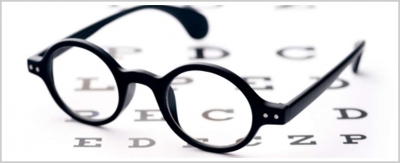Jeder zweite Österreicher ist fehlsichtig – Tendenz steigend
Rund 3,7 Millionen Österreicher:innen über 16 Jahre leiden an Fehlsichtigkeit. Davon sind 1,7 Millionen ständige und 2,0 Millionen gelegentliche Brillenträger:innen. 87% der österreichischen Brillenträger:innen benötigen auch beim Lesen eine Brille, 8% tragen zumindest gelegentlich Kontaktlinsen.
Was bedeutet Fehlsichtigkeit?
Scharfes Sehen setzt voraus, dass der Brennpunkt des einfallenden Lichts exakt auf der Netzhaut liegt. Im optimalen Fall wird das Licht im Auge so gebrochen, dass dies der Fall ist; anderenfalls besteht Fehlsichtigkeit:
• Beim kurzsichtigen Auge (Myopie) liegt der Brennpunkt vor der Netzhaut. Weiter entfernte Gegenstände werden unscharf wahrgenommen.
• Beim weitsichtigen Auge (Hyperopie) ist es umgekehrt: Der Brennpunkt liegt hinter der Netzhaut. Gegenstände in der Nähe erscheinen unscharf.
• Beim astigmatischen oder stabsichtigen Auge (Hornhautverkrümmung) ist der Brennpunkt auf der Netzhaut verzerrt – dementsprechend erscheinen alle Gegenstände verzerrt.
• Im Alter kommt die so genannte Alterssichtigkeit (Presbyopie) hinzu. Das Auge verliert die Fähigkeit, sich auf verschiedene Entfernungen einzustellen, wofür ältere Menschen oftmals beim Lesen eine Sehhilfe benötigen.
Kurzsichtigkeit (Myopie)
Das Auge kurzsichtiger Menschen ist zu lang im Verhältnis zur Brechkraft von Hornhaut und Linse. Das heißt, die Lichtstrahlen, die von weiter entfernten Objekten in das Auge fallen, werden vor der Netzhaut gebündelt und erscheinen somit unscharf. Im Nahbereich sieht das Auge dagegen besser.
Hochgradige Kurzsichtigkeit kann mit einer Dehnung der Netzhaut einhergehen und gilt als Risikofaktor für Netzhautdefekte oder Netzhautablösung. Diese hochgradige Myopie kann erblich sein.
Die Kurzsichtigkeit lässt sich mit Zerstreuungslinsen (Minusgläser) in Brillen oder entsprechenden Kontaktlinsen ausgleichen. Diese Linsen sind in der Mitte dünner als am Rand. Sie öffnen das Bündel der Lichtstrahlen und sorgen so dafür, dass es sich erst auf der Netzhaut zum Brennpunkt vereinigt.
Wer eine Sehhilfe als lästig empfindet, kann die Kurzsichtigkeit auch operativ mittels Augenlaser (refraktiver Eingriff) korrigieren lassen.
Es zeigt sich weltweit eine Tendenz zur Zunahme der Kurzsichtigkeit. Im Jahr 2030 werden nach Berechnungen bereits 50% aller Kinder kurzsichtig sein. In vielen asiatischen Ländern wie z. B. China sind bereits heute mehr als 80% aller Kinder kurzsichtig. Hier finden Sie Informationen über die Behandlung der Myopie bei Kindern.
Weitsichtigkeit (Hyperopie)
Im Gegensatz zur Kurzsichtigkeit ist bei der Weitsichtigkeit das Auge zu kurz geformt. Das hat zur Folge, dass sich die Lichtstrahlen erst hinter der Netzhautebene vereinigen.
Mit Sammellinsen, die in der Mitte dicker sind als am Rand, lässt sich die Weitsichtigkeit ausgleichen. Ebenso ist innerhalb bestimmter Grenzen eine operative Korrektur mittels refraktiver Chirurgie möglich.
Stabsichtigkeit, Hornhautverkrümmung (Astigmatismus)
Normalerweise ist die Hornhaut kugelig geformt und hat dadurch eine gleichmäßige Brechkraft. Eine astigmatische Hornhaut ist so gekrümmt, dass die Brechkraft in den einzelnen Ebenen (Meridiane) der Hornhaut unterschiedlich stark ausgeprägt ist. Einfallende Lichtstrahlen werden daher nicht als Punkt gebündelt auf der Netzhaut abgebildet, sondern zu einem Strich bzw. Stab verzogen (daher die Bezeichnung „Stabsichtigkeit“ oder Hornhautverkrümmung). Diese Form der Fehlsichtigkeit geht häufig mit Kurz- oder Weitsichtigkeit einher.
Mit zylindrisch geformten Brillengläsern oder speziellen Kontaktlinsen lässt sich der Astigmatismus ausgleichen. Verschiedene operative Verfahren, wie zum Beispiel ein Laser-chirurgischer Eingriff oder die Implantation torischer Linsen, erlauben auch die Korrektur der Hornhautverkrümmung.
Alterssichtigkeit (Presbyopie)
Die Fähigkeit des Auges, die Sehschärfe aktiv an verschiedene Entfernungen anzupassen, nennt man „Akkommodation“. Damit ist das menschliche Auge in der Lage sowohl weit entfernte Dinge scharf zu sehen als auch solche, die in der Nähe liegen.
Diese Fähigkeit geht jedoch etwa ab dem 45. Lebensjahr verloren. Ab dann können Normalsichtige nur noch Gegenstände in der Ferne scharf sehen, für die Nähe, beispielsweise zum Lesen einer Zeitung, benötigen sie eine Lesebrille. Kurzsichtige, die von Natur aus in der Nähe besser sehen, kommen meist etwas länger ohne Lesebrille aus.

Trotz intensiver Forschung auf diesem Gebiet ist es bis heute nicht möglich, Alterssichtigkeit zu heilen bzw. die Akkommodation (Naheinstellungsreaktion) vollständig wiederherzustellen.
Bei der Alterssichtigkeit besteht die Therapie in der Regel darin, mithilfe einer Lese – oder Gleitsichtbrille oder multifokalen Kontaktlinsen wieder scharfes Sehen in der Nähe zu ermöglichen. Dies gelingt mit einer sogenannten Sammellinse.
Die Stärke der Brille richtet sich nach dem Alter und der gewünschten Lese- beziehungsweise Arbeitsentfernung. Dabei gilt: Je näher sich der Lesetext am Auge befinden soll, desto stärker muss die Brille sein. Wenn Sie neben Ihrer Alterssichtigkeit bereits eine Fehlsichtigkeit (d.h. Astigmatismus, Weit- oder Kurzsichtigkeit) haben, ist eine kombinierte Brille (eine sogenannte Gleitsichtbrille) für Sie am wahrscheinlichsten geeignet.
Statt einer Brille können zur Korrektur der Alterssichtigkeit auch Kontaktlinsen eingesetzt werden: Wenn Sie Ihre Fehlsichtigkeit bisher mit Kontaktlinsen korrigiert haben und auch eine einsetzende Alterssichtigkeit mit dieser Sehhilfe ausgleichen möchten, können Sie sich entsprechend für Multifokallinsen (auch Mehrstärkenlinsen oder Gleitsichtkontaktlinsen genannt) entscheiden.
Neben Brillen und Kontaktlinsen stehen zur Therapie bei Alterssichtigkeit auch chirurgische Verfahren der zur Verfügung: Mit speziellen Linsenimplantaten, sogenannten Multifokallinsen oder EDOF Linsen (Linsen mit erweiterter Tiefenschärfe), können Patient:innen in einigen Fällen komplett auf die Lesebrille verzichten. Diese Implantate verteilen das Licht auf mehrere Brennpunkte, so dass sowohl im Fern- als auch im Zwischen- und Nahbereich scharfes Sehen wieder möglich ist.
Sollte beispielsweise wegen eines Grauen Stars die Entfernung der körpereigenen Linse anstehen, ist bei dieser Gelegenheit das Einsetzen solcher Speziallinsen für manche Patient:innen eine Möglichkeit, auch im Alter großteils keine zusätzliche Lesebrille zu benötigen. Ihre Augenärztin oder Ihr Augenarzt wird in diesen Fällen gemeinsam mit Ihnen genau besprechen, welche Erwartungen Sie mit der Operation verknüpfen und welches Ergebnis zu erwarten ist.
Mittels refraktivem Hornhautlaser steht uns seit einigen Jahren die Möglichkeit zur Verfügung, Alterssichtigkeit mittels Excimer Laser (z.B. PresbyMAX) zu korrigieren.
Das Prinzip dieser Methode besteht darin, die Hornhaut mittels Laser zu modellieren: für das Sehen in der Nähe das Zentrum und das Sehen in der Ferne die Peripherie. Dadurch ergibt sich eine gute Sehschärfe in allen Entfernungen – ob nah oder fern.
